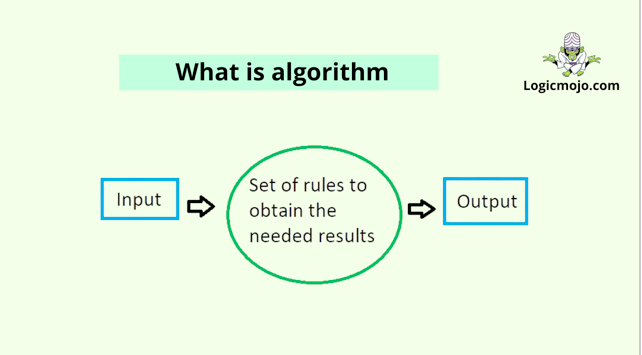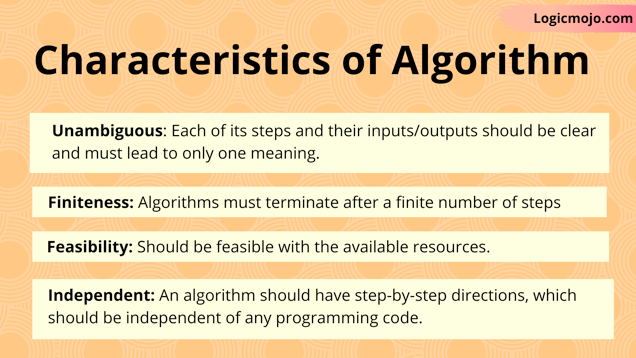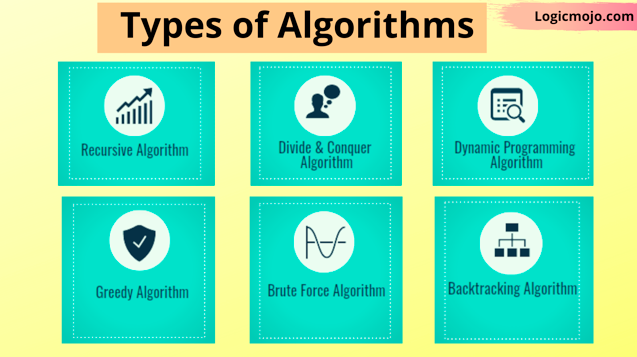An algorithm is a finite set of instructions or logic that must be written in a specific order to complete a predetermined goal. An algorithm is not a complete programme or code; rather, it is the basic logic (solution) of a problem, which can be stated in a flowchart or as a high-level description in pseudocode.

Characteristics of Algorithm
To cook the recipe, one would not follow any written directions, but only the customary one. Similarly, not all written computer instructions are algorithms. In order for a set of instructions to be considered an algorithm, they must meet the following criteria:

- Unambiguous − Algorithm should be clear and unambiguous. Each of its steps (or phases), and their inputs/outputs should be clear and must lead to only one meaning
- Input − An algorithm should have 0 or more well-defined inputs.
- Output − An algorithm should have 1 or more well-defined outputs, and should match the desired output.
- Finiteness − Algorithms must terminate after a finite number of steps.
- Feasibility − Should be feasible with the available resources.
- Independent − An algorithm should have step-by-step directions, which should be independent of any programming code.
Algorithm is a step-by-step procedure, which defines a set of instructions to be executed in a certain order to get the desired output. Algorithms are generally created independent of underlying languages, i.e. an algorithm can be implemented in more than one programming language.
From the data structure point of view, following are some important categories of algorithms −
- Search − Algorithm to search an item in a data structure.
- Sort − Algorithm to sort items in a certain order.
- Insert − Algorithm to insert item in a data structure.
- Update − Algorithm to update an existing item in a data structure.
- Delete − Algorithm to delete an existing item from a data structure.
How to Write an Algorithm?
There are no well-defined standards for writing algorithms. Rather, it is problem and resource dependent. Algorithms are never written to support a particular programming code. As we know that all programming languages share basic code constructs like loops (do, for, while), flow-control (if-else), etc. These common constructs can be used to write an algorithm. We write algorithms in a step-by-step manner, but it is not always the case. Algorithm writing is a process and is executed after the problem domain is well-defined. That is, we should know the problem domain, for which we are designing a solution.
Types of Algorithm

- Brute Force Algorithm: The simplest possible algorithm that can be devised to solve a problem is called the brute force algorithm. To device an optimal solution first we need to get a solution at least and then try to optimise it. Every problem can be solved by brute force approach although generally not with appreciable space and time complexity.
- Greedy Algorithm : In this algorithm, a decision is made that is good at that point without considering the future. This means that some local best is chosen and considers it as the global optimal. There are two properties in this algorithm.
- Greedily choosing the best option
- Optimal substructure property: If an optimal solution can be found by retrieving the optimal solution to its subproblems.
- Recursive Algorithm: This is one of the simplest to devise algorithms as it does not require specifically think about every subproblem. This means we just need to think about the existing cases and the solution of the simplest subproblem, all other complexity will be handled by it automatically. Recursion is a very powerful tool although we should always take care of memory management here as recursion works using recursive stack which is called every time recursion function is invoked. Recursion simply means calling itself to solve its subproblems.
- Backtracking Algorithm : It is an improvement to the brute force approach. Here we start with one possible option out of many available and try to solve the problem if we are able to solve the problem with the selected move then we will print the solution else we will backtrack and select some other and try to solve it. It is a form of recursion, it’s just that when a given option cannot give a solution, we backtrack to the previous option which can give a solution, and proceed with other options.
- Divide & Conquer Algorithm : This is one of the most used algorithms in programming. This algorithm divides the problems into subproblems and then solve each of them and then combine them to form the solution of the given problems.Again, it is not possible to solve all problems using it. As the name suggests it has two parts: Divide the problem into subproblems and solve them.
- Combine the solution of each above problems.
- This algorithm is extensively used in various problems as it is quite stable and optimal for most of the problems asked.
- Dynamic Algorithm : This is the most sought out algorithm as it provides the most efficient way of solving a problem. Its simply means remembering the past and apply it to future corresponding results and hence this algorithm is quite efficient in terms of time complexity.
- Optimal Substructure: An optimal solution to a problem contains an optimal solution to its subproblems.
- Overlapping subproblems: A recursive solution contains a small number of distinct subproblems.
- Bottom-Up Approach: Starts solving from the bottom of the problems i.e. solving the last possible subproblems first and using the result of those solving the above subproblems.
- Top-Down Approach: Starts solving the problems from the very beginning to arrive at the required subproblem and solve it using previously solved subproblems.
Greedy Algorithm does not always work but when it does, it works like a charm! This algorithm is easy to device and most of the time the simplest one. But making locally best decisions does not always work as it sounds. So, it is replaced by a reliable solution called Dynamic Programming approach.
This is the most sought out algorithm as it provides the most efficient way of solving a problem. Its simply means remembering the past and apply it to future corresponding results and hence this algorithm is quite efficient in terms of time complexity.
This algorithm has two version:
 Logicmojo
Logicmojo